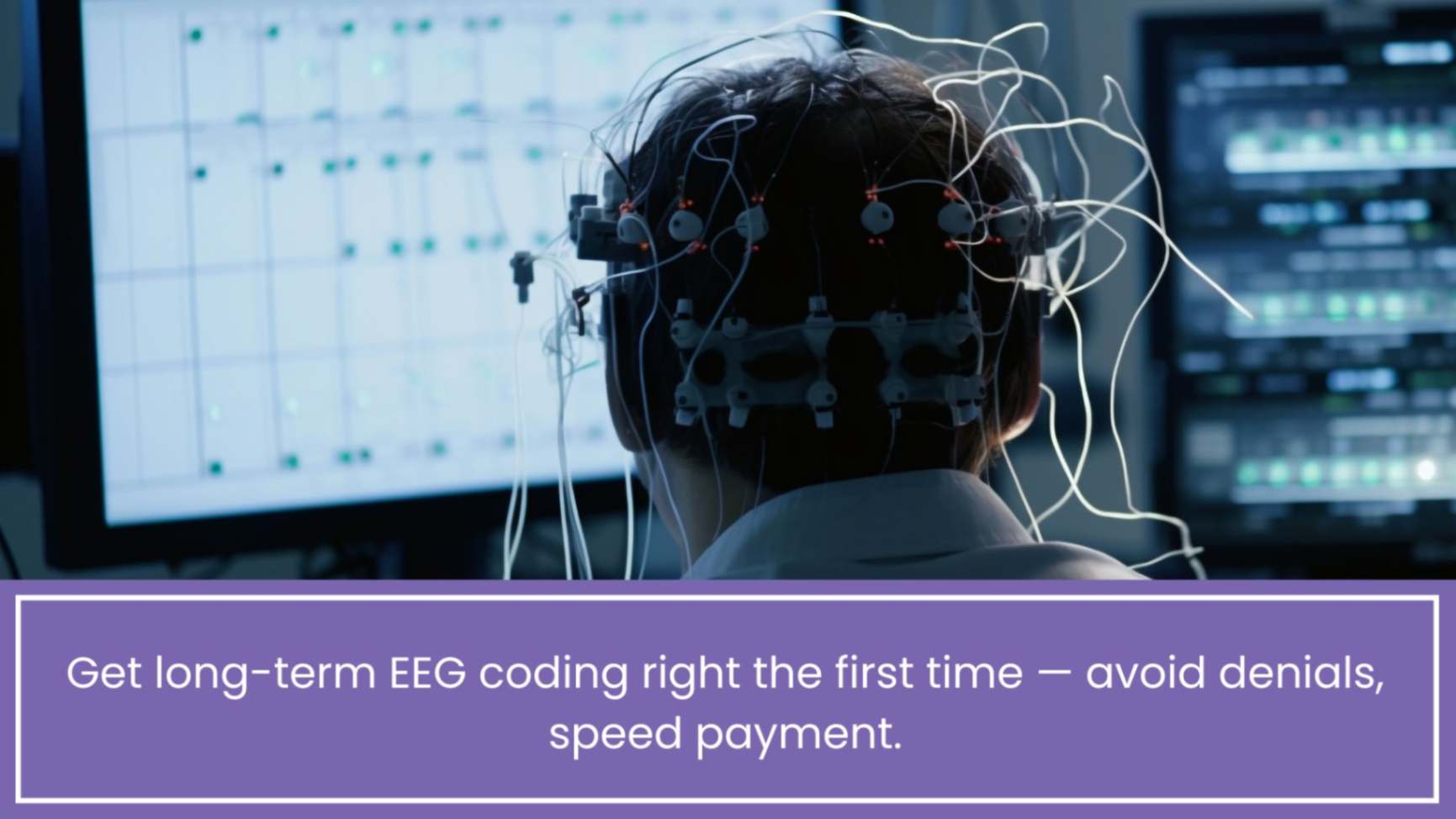Long-term EEG CPT Codes
Long-term EEG CPT Codes (ambulatory EEG, video-EEG, EMU monitoring) is high-value but high-risk from a billing standpoint: the CPT codes are time-and-feature based (recording duration, video on/off, and whether the physician had real-time access), and payers — including Medicare contractors — expect tightly matched documentation to support each billed unit. The 2020 CPT restructuring replaced older 959xx/957xx entries with the 95700–95726 range, so many facilities still need refreshers on the new rules.
Table of Contents
Overview of Long Term EEG Monitoring Codes
- CPT Code 95700 — Routine EEG (8-channel baseline; check payer policy).
- CPT Code 95705–95716 — Technical component codes for continuous/unmonitored/intermittent recordings (time thresholds vary; some codes include video).
- CPT Code 95717–95726 — Professional component/physician review codes split by whether the physician had real-time access (daily reports for each 24-hour segment) vs. codes for post-hoc review. Knowing whether the physician monitored data during recording (continuous/intermittent monitoring) is essential to choose correctly.
Documentation required for EEG Cpt Codes
Accurate billing starts in the neurodiagnostic lab. Every claim should be backed by these elements:
- Clear start/stop timestamps for each recorded segment — CPT timing rules count monitored recording minutes/hours; units must match time logs.
- Channels & montage (e.g., 16- or 24-channel montage) and electrode placement notes.
- Video presence flag: explicit statement if video was recorded and whether it was synchronized with EEG. Payers reimburse differently for VEEG.
- Physician monitoring level: unmonitored (no real-time review), intermittent (technologist/physician reviews at set intervals), or continuous (real-time review and intervention). This determines whether you bill 9571x–9572x vs 9572x PC/TC splits.
- Interpretive report: a signed final read (date/time) with impression, spike/seizure detection summary, and physician time spent reviewing/interpretation if relevant.
Tip: Attach the automated time log and a one-line tech summary (e.g., “24:00 monitored recording; video synced; physician reviewed daily; final report signed 10/10/2025”) to the claim when possible.
Common Denial challenges and how to avoid them
- Missing time math / mismatched units: Payers commonly deny when claimed units don’t match recorded hours or when rounding rules are applied incorrectly. Reconcile claims to time logs before submission.
- Using real-time codes without evidence of monitoring: If the physician did not have access to the EEG during recording, don’t bill codes intended for continuous physician access. Train techs and clinicians to document the monitoring level consistently.
- Ignoring local coverage/medical necessity rules: MACs and payers publish LCDs and policy articles for ambulatory EEG; those rules (e.g., requiring a prior routine EEG) must be followed. Check CMS/payer guidance before billing.
Workflow of Quick Audit Proof
- Tech + coder huddle at procedure close: confirm total monitored minutes, whether video was recorded or synced, and whether the physician had real-time access. Document this in a one-line tech note.
- Auto-attach the time log to the claim and route to physician for a signed addendum if anything is ambiguous. This small extra step prevents many retrospective documentation requests.
Example Secenarios For Code Selection
- 24-hour ambulatory EEG with no video, no real-time physician monitoring: TC/technical component — code from 95705–95716 for the technical; physician would bill the appropriate post-hoc review code in the 95721–95726 range depending on total hours. (Exact code depends on time brackets — see AAN/NAEC code matrix.)
- Multi-day EMU with daily physician review and summary reports: Use 95717–95720 for professional services when daily reports and physician access criteria are met; bill the matching technical codes for the recording.
(If you want, I can create a one-page code matrix that maps recording hour brackets to specific CPTs used by your techs.)
Query to physician (chart query):
“Please confirm whether the attending neurologist had real-time/continuous access to the EEG data during the recording (i.e., monitored events and provided daily review). If yes, state frequency of review (continuous / every X hours) and confirm daily report generation.”
Appeal justification (sample denial overturn):
“Attached time log (electrodes applied 08:00; recording stopped 08:00 +24h), daily physician notes dated XX/XX with summaries for each 24-hour segment, and final signed interpretive report dated XX/XX. Documentation supports physician real-time access and daily review for codes 95717–95720.” Include the time log and daily notes as exhibits.
Best Practices For Audit Preparation
- Keep a central coding policy PDF (department intranet) with the mapping table, one-line tech note template, and examples for common study types. Reference AAN/NAEC guidance for staff training.
- Run monthly reconciliation reports: claimed units vs. recorded hours (spot-check 10% of studies).
- Keep MAC/LCD links handy and check them quarterly — CMS and large payers update ambulatory EEG policies and medical necessity statements.
Conclusion:
Long-term EEG codes reward discipline. The things that cut denials fastest are: tidy, automated time logs; consistent tech language about monitoring level; explicit video flags; and a signed physician interpretive report. Keep an AAN/NAEC-based coding cheat-sheet on the department intranet and build the two-step huddle + time-log attachment into your standard workflow — you’ll see fewer denials and faster payments.
ALSO READ – Decoding CPT: Your Guide to Codes and Regulations 2024






